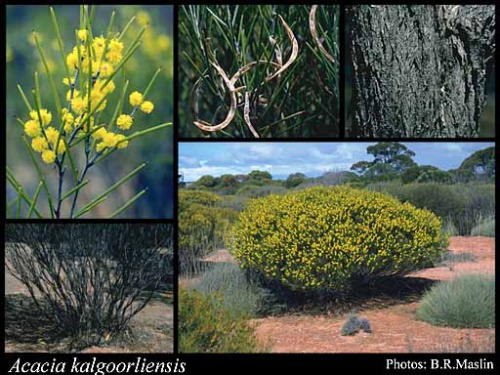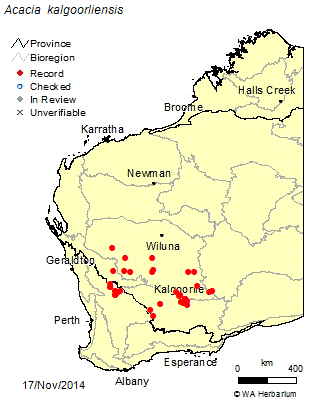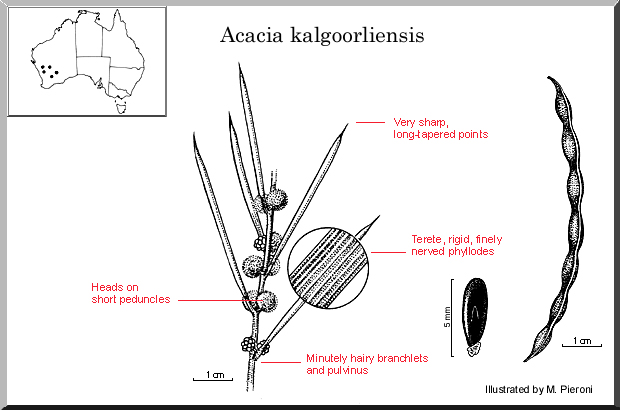Acacia kalgoorliensis
Contents
General Plant Info
Acacia kalgoorliensis also known as Kalgoorlie Wattle native to Western Australia it has dense, rounded multistemmed shrub 1–3 m high. Branchlets subappressed puberulous, the hairs white with red resin-hairlets intermixed. Phyllodes erect, straight, terete, 3–7 cm long, 1.5 mm diam., tapering into long, hard, dark, straight, sharply pungent tip, rigid, glabrous except pulvinus crispate-sericeous, with numerous slightly raised, closely parallel nerves; stomata evident between the nerves; glands normally 2. Inflorescences simple, 2 per axil; peduncles usually 0.5–1.5 mm long, glabrous or with scattered red resin-hairlets; heads globular to widely ellipsoid, 3–6 mm diam., 15–22-flowered, golden. Flowers 5-merous; sepals free. Pods linear, raised over and constricted between seeds, shallowly curved, to 7.5 cm long, 3 mm wide, chartaceous, glabrous. Seeds longitudinal, narrowly elliptic to oblong-elliptic, 4-4.5 mm long, dull, dark brown; aril terminal.
There are four collections from areas more than 300 km NW of the principal occurrence of A. kalgoorliensis in the general vicinity of Kalgoorlie; these closely resemble the species but have broadly ellipsoid, 30–40-flowered heads on peduncles 2–4 mm long; these have been treated as representing an informal variant of the species.
Conservation Status
A Priority 3 taxon on the Department of Conservation and Land Management’s Declared Rare and Priority Flora List.
Etymology
The name of the species is derived from the Western Australian goldfields town, Kalgoorlie, where the species is centred.
Geographic distribution
Occurs in the Kalgoorlie and Marvel Loch (c. 200 km WSW of Kalgoorlie) areas with a variant scattered c. 320- 560 km NW of Kalgoorlie (near Wubin and Noongal and Yuinmery Stns), W.A. Grows in rocky loam, clay and clay loam on low hills in eucalypt woodland. The variant grows in sandy clay and loam over calcrete in eucalypt open woodland and Acacia tall shrubland.
Identification
There is considerable similarity also between Acacia dissona, particularly the typical variety, and A. kalgoorliensis R.S. Cowan & Maslin which has generally longer phyllodes with the apex drawn out into a long spinose tip, mostly shorter peduncles, pods with appressed, red resin-hairs and seeds with an aril that does not invest the seed apex.[1]
The differences separating the two varieties comprising the species are mostly to be found in the pods and seeds. There are, however, qualitative differences in the degree of pungency of the phyllodes and the colour of the nerves.
Alkaloid content
Other uses
Extraction
Cultivation
Suppliers
Links
References
- ↑ Cowan, R.S., & Maslin, B.R. (1998). Nuystia, WESTERN AUSTRALIA’S JOURNAL OF SYSTEMATIC BOTANY, 10(2), 210. Retrived from: http://florabase.dpaw.wa.gov.au/science/nuytsia/232.pdf
World Wide Wattle, Acacia kalgoorliensis(2013). Retrived from: http://www.worldwidewattle.com/speciesgallery/kalgoorliensis.php
FloraBase, Acacia kalgoorliensis R.S.Cowan & Maslin. Retrived from: http://florabase.dpaw.wa.gov.au/browse/profile/14610


